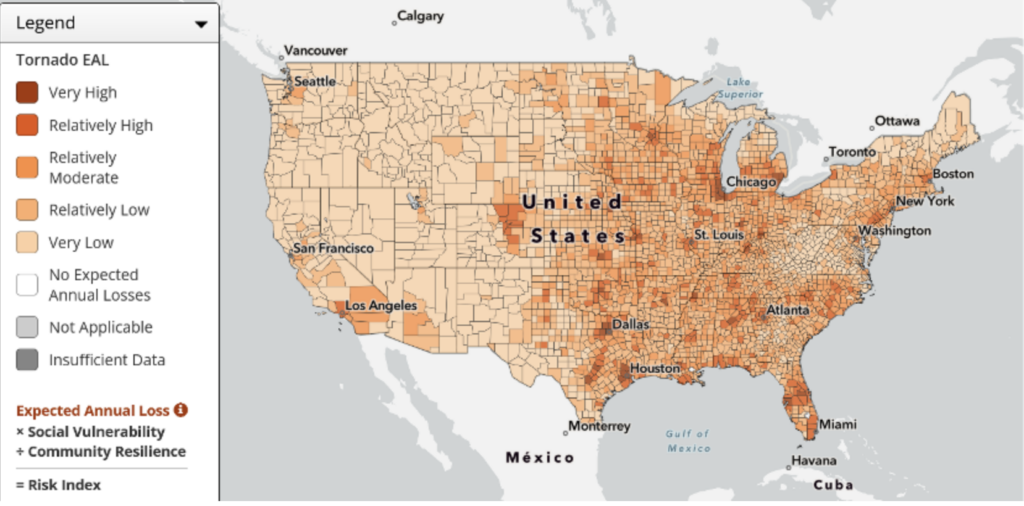Tornado outbreaks occur when a storm system propelled by a strong, southward dip in the jet stream punches into the Plains, Midwest or South. This is accompanied by warm and humid air flowing northward out of the Gulf of Mexico. The jet stream provides deep wind shear, or changing wind speed and direction with height, supportive of rotating supercell thunderstorms. If wind shear is particularly strong in the first few thousand feet near the surface, these supercells would more likely produce tornadoes.
In recent years “Hail and Tornado Alley” has moved from the South Central and Mid Central area of the US to expanded and more variable areas of the country. In the early spring, the greatest threat of severe thunderstorms with associated hail and the potential for tornadic conditions is from Eastern OK, NE TX, AR and Northern LA, MS and AL. The threat ratio decreases but still present and includes the Gulf Coast, FL, the South and Central Eastern Seaboard, the Carolinas, TN, KY, OH, IN, IL, MO, KS, IA and Western CA from San Diego to San Francisco.
For example, the potential for tornadoes in the South is much lower in June compared to March. Although moisture is abundant across the southern region in late spring, the strong jet stream needed to help make conditions favorable for tornadic thunderstorms moves northward toward the Canadian border
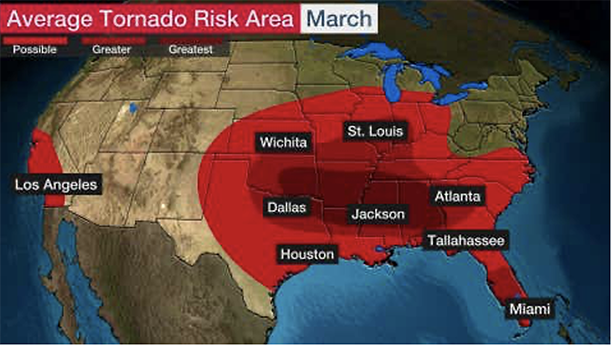
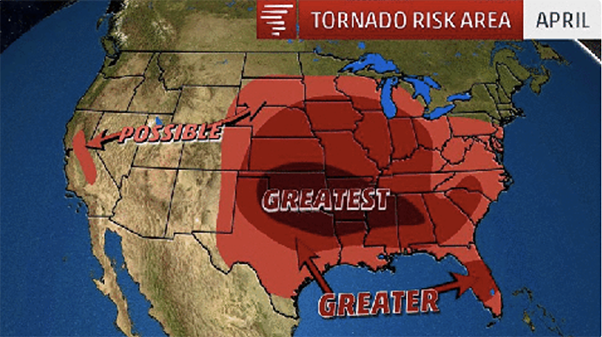
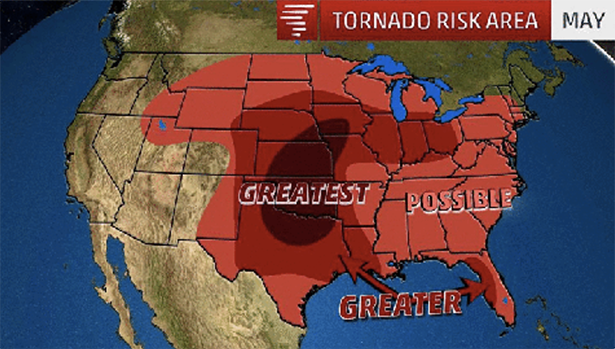
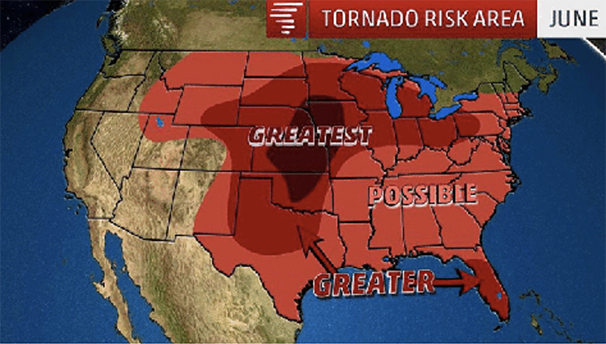
By June the greatest threat area has moved from the South and Southeast to Mid and North Central US with above average risk covering all of the US except for the mountainous and very dry regions of the West and Far West areas of the US.
Typically we associate tornados with their ominous funnel cloud covering a relatively small area but a tornado’s path can be up to 100 miles with damaging winds up to ten miles from the center of its path. These winds can vary dramatically in intensity and potential damage as depicted in the following chart.
The Fujita Scale of Tornado Intensity
| F-Scale Number | Intensity Phrase | Wind Speed | Type of Damage Done |
|---|---|---|---|
| F0 | Gale tornado | 40-72 mph | Some damage to chimneys; breaks branches off trees; pushes over shallow-rooted trees; damages sign boards. |
| F1 | Moderate tornado | 73-112 mph | The lower limit is the beginning of hurricane wind speed; peels surface off roofs; mobile homes pushed off foundations or overturned; moving autos pushed off the roads; attached garages may be destroyed. |
| F2 | Significant tornado | 113-157 mph | Considerable damage. Roofs torn off frame houses; mobile homes demolished; boxcars pushed over; large trees snapped or uprooted; light object missiles generated. |
| F3 | Severe tornado | 158-206 mph | Roof and some walls torn off well constructed houses; trains overturned; most trees in forest uprooted |
| F4 | Devastating tornado | 207-260 mph | Well-constructed houses leveled; structures with weak foundations blown off some distance; cars thrown and large missiles generated. |
| F5 | Incredible tornado | 261-318 mph | Strong frame houses lifted off foundations and carried considerable distances to disintegrate; automobile sized missiles fly through the air in excess of 100 meters; trees debarked; steel re-inforced concrete structures badly damaged. |
In order to limit damage a structure must be securely bonded throughout from the foundation to walls and including the roof with no breaks or flex points.
Closed cell spray polyurethane foam (SPF), when applied in walls, ceilings, floors and on the roof, ranging in densities from 2.0 to 3.5 pounds per cubic foot (PCF), protects the structure from serious and costly damage (see following ratings and wind speed charts). It forms a seamless contiguous envelope for the structure which allows it to resist the forces of all but the most powerful winds. It can alleviate concerns of builders, contractors and facility owners due to the increasing number and intensity of severe storms in the United States and the resulting damage that may be incurred to commercial and residential structures.
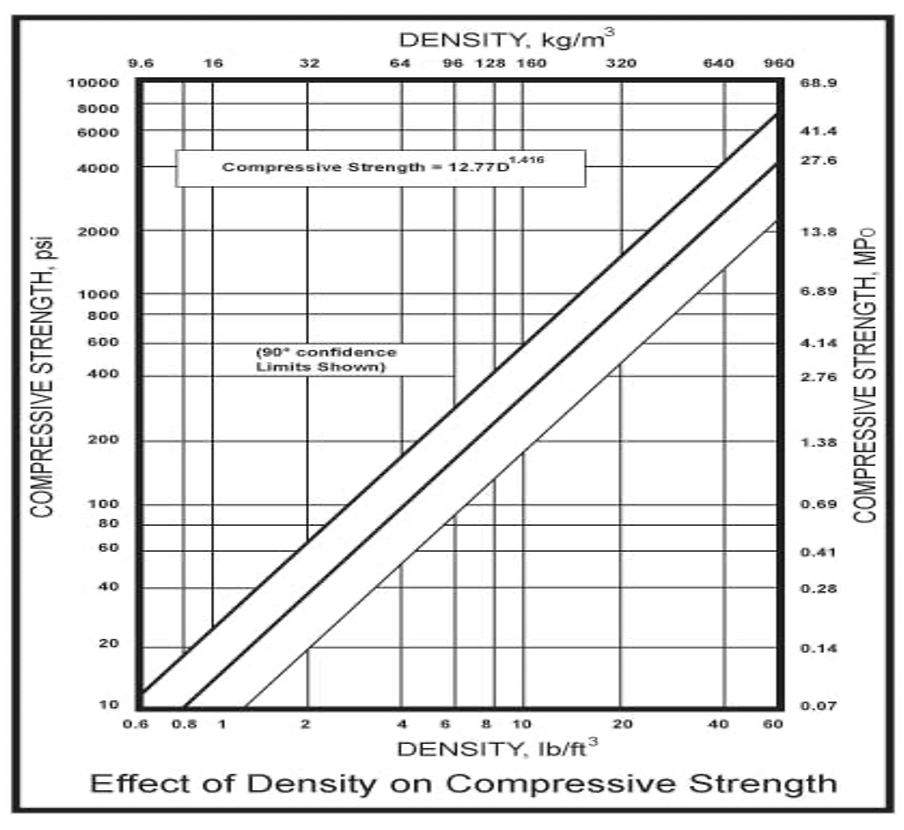
Structural Strength and Wind Resistance – The application of closed cell SPF in above grade walls and roofs increases the structural strength of buildings and assists with wind resistance. When installed, closed cell SPF provides a waterproof monolithic structure essentially gluing the assembly together which reduces the potential for movement and adds a compressive strength ranging from 50-90 PSI (7,920 – 12,960 psf) and tensile strength ranging from 65-100 PSI (9,360 – 14,400 psf), depending on the density of the foam. Closed cell SPF is typically applied ranging in densities from 2.0 – 3.5 lbs/ft3and thicknesses from 2 to 8 in. The thicker the foam the greater level of protection available. This performance with their associated ratings will protect structures from extreme weather wind and hail events. Special bracing for wind resistance is not required for strengthening purposes when using closed cell spray foam in walls. The tensile strength of 3.0 lb. foam is equivalent to oak, plus it forms a monolithic structure which greatly resists external shearing forces and acts to maintain the structural integrity of buildings during extreme weather events in hot or cold environments.
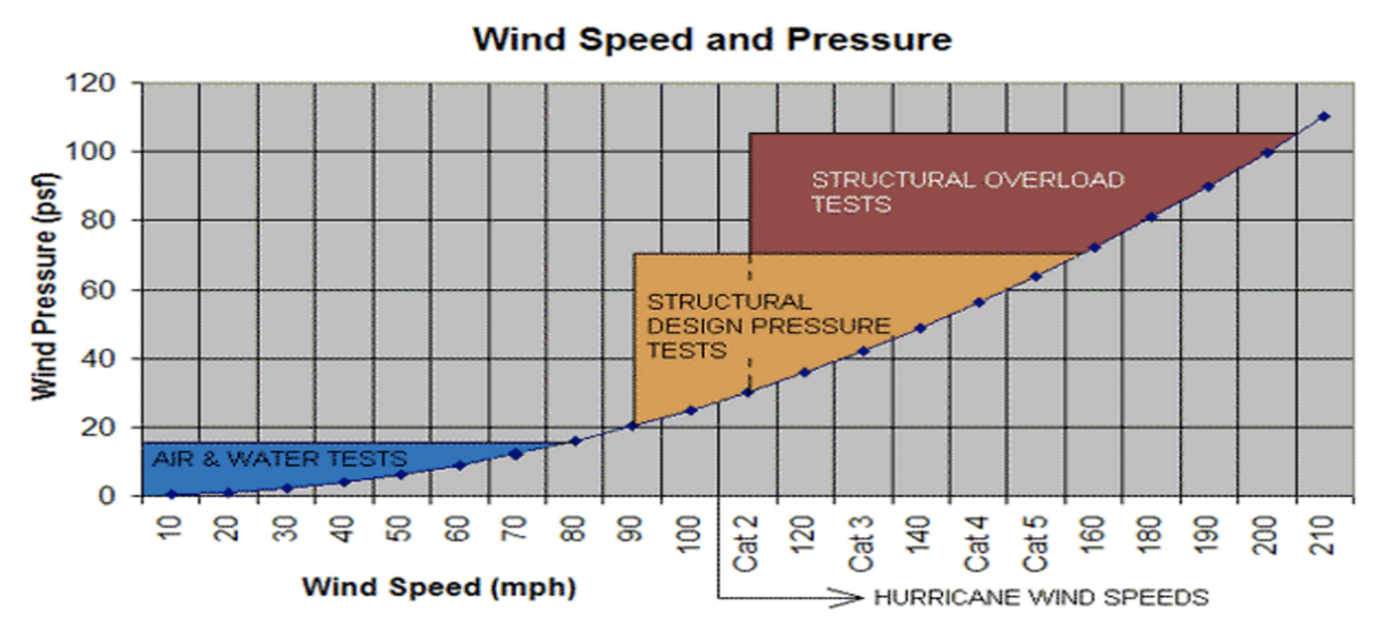
It also provides greatly improved energy efficiency, a stable interior environment and waterproofing and flood resistance to your building. Closed-cell foams do require specialized equipment and professional installation for proper application and performance.
Warning: Closed cell SPF has not been tested above 200 mph and it is not certified as a tornado shelter. Note: Closed cell SPF is routinely used at 4-6 lb/ft3 with thickness up to 8” in fortifying foundations and roadways. When applied using higher densities and thicknesses in excess of 4” the lbs/ft2 strength factor is hundreds of thousands of lbs/ft2. These ratings indicate support of anecdotal evidence of structures fortified with closed cell SPF, from the foundation to the roof, surviving tornadic winds.
In addition, several studies done at Texas A&M University and a school district in Southern Texas indicate that the energy savings alone paid for the roofing system and all the other benefits such as the following were essentially included:
- Storm damage resistant along with easy repair since damage, if any is localized.
- Minimal maintenance.
- Stronger more sustainable buildings. Especially important in areas of extreme weather
- Year round comfort of interior.
- Roof contouring to eliminate drainage issues and water ponding.
- Life of the roofing system is indefinite as it easily renewed with cleaning and/or additional coatings to prevent weathering damage to roof.
- 5-30 year renewable warranties available.
Our GreenSeal 2.0 to 3.5 lb/ft3 and higher custom density products are the best solution to strengthen and protect your roof and walls from extreme weather conditions in any area of the US. Free Consultation and Inspection available upon request.


